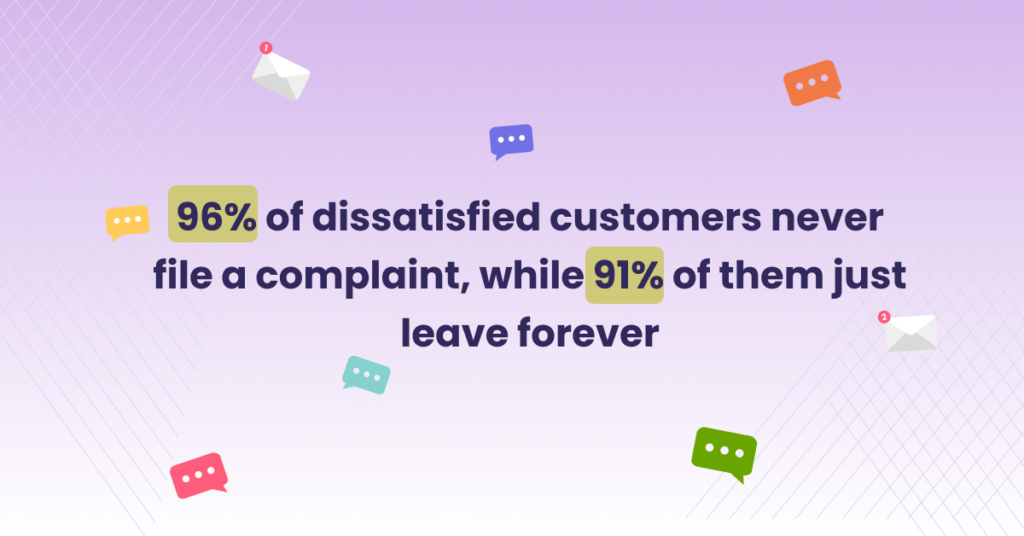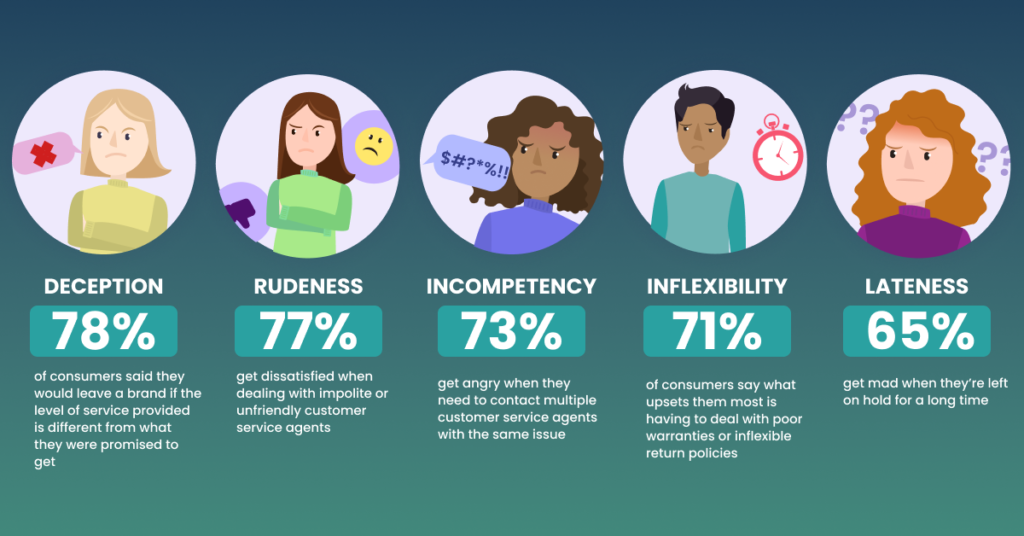A dissatisfied customer is a business’s worst nightmare. The ultimate goal for every company is to create positive experiences for their clients. And if you fail at that, the consequences can be devastating.
Dissatisfaction can come in a variety of forms. From simply not meeting the expectations of customers, to giving them the runaround when they’re asking for help, to flat out insulting them. But no matter what form it takes, it’s important to handle it immediately and effectively, before it becomes a crisis.
Here’s where you start.
What is a dissatisfied customer and customer dissatisfaction in general?
Dissatisfied customers are not just someone who filed a complaint. It’s a much deeper problem that, when left ignored, can get your company into the danger zone.
But here’s one thing to remember: most upset customers don’t complain — they just leave. A recent research found that 96% of dissatisfied customers never file a complaint, while 91% of them just leave forever.

So if you see a noticeable increase in customer dissatisfaction, as a rule of thumb, assume that there are actually many more of them and it is time for some change.
But let’s first take a closer look at the meaning of customer dissatisfaction.
Customer dissatisfaction occurs when customers feel that their needs, wants and expectations have not been met by a company or service provider — and there’s usually a snowballing effect to it, several things going wrong one after another.
This is different from complaints because it doesn’t necessarily mean that there was fault on behalf of either party. It just means that one side didn’t meet up with their end of an agreement or contract.
Here’s a fairly common customer dissatisfaction example: someone finds that an item they bought online doesn’t live up to their expectations (e.g., if they ordered a new shirt but received something completely different); someone uses your business’ services but isn’t happy with them; or even someone who brings back something they purchased because they don’t like how it works out in practice.
Why is customer dissatisfaction dangerous?
In a recent research, Esteban Kolsky found that 13% of dissatisfied customers will talk to at least 15 people about their bad customer experience.
And we all know that rumor and bad news can spread much faster than good news. Building your brand reputation can take years, yet breaking it can take a day.
Reasons for customer dissatisfaction
What causes customer dissatisfaction? It’s a question every business seeks to answer, because the answer lies at the heart of how to improve customer satisfaction.
There are two core reasons why a customer can feel unhappy with your product or service.
The first is the simple fact that they don’t feel it’s worth their money—the product isn’t living up to its quality, or they’ve spent too much on something that just doesn’t feel worth it.
The second reason is that they feel cheated — they feel misled by false advertising, weak information on value, poor customer service, or false promises.
So the causes of customer dissatisfaction can lie in a product, but they can also stem from the quality of your customer service.You have to know what your customers are doing when they aren’t satisfied with your product or service—what are their thoughts and feelings about it? What are they doing with it (or not doing)?

Here’s what causes customers to become dissatisfied most of all in customer service, according to Business 2 Community:
- For 78% of consumers, it’s deception — when you fail to deliver the promised level of service
- 77% of customers report rudeness — they won’t stay loyal to a brand with impolite and unfriendly customer service
- 73% of people hate incompetence — we all get angry when having to talk to multiple customer service agents about the same problem
- 71% of respondents complained of inflexibility — having to deal with poor warranties or inflexible return policies
- 65% get dissatisfied because of lateness — being left on hold for 10 minutes is never fun
Effects of customer dissatisfaction
Needless to say, dissatisfied customers are bad for business.
Whether it’s a product that doesn’t work, a customer service representative who doesn’t listen, or a company that makes promises they don’t keep — unhappy customers will spread their dissatisfaction to everyone they know.
When a business fails to address underlying issues or corrects them in a way that doesn’t satisfy their customers, customers develop an attitude about the business called “complaining behavior.”
Complaining behavior is characterized by behaviors such as making negative comments about the business/product and taking actions like returning products that are not in line with how customers felt they were marketed. The overall effect is decreased customer loyalty and a general feeling of dissatisfaction.
In a recent poll by American Express, 33% of Americans said they will switch to a competitor after a single negative customer service experience. At the same time, New Voice Media found that 20% of dissatisfied customers take the trouble of making a public complaint on social media when a negative customer experience takes place.
There are multiple ways to put it but here is the main point — dissatisfied customers mean no more business.
So what do you do to manage the problem?
How to handle customer dissatisfaction

Is understanding your customers, even obsessing over them, really so important for a business to succeed in 2022? Here are some numbers to answer that question.
- 9 out of 10 customers are ready to pay extra as long as they get a good customer experience (Salesforce)
- 80% of American consumers say that knowledgeable help, speed, convenience, and friendly service are the most important elements in their customer experience (PwC)
- 70% of consumers will continue doing business with a brand if their complaint gets resolved properly (Salesforce)
- 7 out of 10 people value getting the same agent handling their case every time they interact with a company (Genesys)
But what if your customer service team faltered and a few mistakes already happened? Here’s what you do for liquidating and preventing customer dissatisfaction.
Act fast
In the daily bustle of doing business, sometimes there’s a breakdown in communication between you and your clients, and it can create an unhappy customer.
The first step to managing customer dissatisfaction is dealing with it as soon as possible. When you’re able to address a problem before it becomes a problem for everyone, everyone wins in the end. Your customer is satisfied with their experience, and you’re able to build business relationships that will continue to grow.
Pinpoint the reason
The core rule to managing customer dissatisfaction is to find out what makes the customer dissatisfied. A good way to do this is by openly asking the customer what they dislike about your business. Sometimes, you can easily fix the problem with one or two solutions.
For example, if a customer feels like your products aren’t worth the price you are charging, lowering your prices could be a quick solution to their problem. But if you decrease your prices and find that the dissatisfied customer still isn’t happy, there might be some bigger problems within your company that need to be solved first before any change will make your customer satisfied with you again.
Make your customer feel heard
A big part of the reason you have unhappy customers is that they don’t feel heard and understood. Even worse, they might feel ignored or brushed off because you’re not listening or responding to them.
It’s important to let your customers speak their minds before even attempting to solve the problem.
The first step is simply listening. You can guide your customer through the process by asking questions such as “How is it that I can help?” and “What do you need from me?”
The goal isn’t just to get information—it’s also an opportunity for you to let them know that you’re listening and will be there for them throughout the process.
Enable customer support operations
Customer service can get clunky. And the more agents you have — the clunkier it will get with all the quality assurance and metrics data around.
The best way to empower your agents lies in simplifying and unifying all customer operations, from QA and performance management to performance coaching and reporting, within one platform.
You would need to do this so nobody has to use Excel sheets, continuously track data and manually update it. Automating those processes can mean a world of difference for your customer support teams as they will finally be able to focus on customers instead of numbers.

Continuously coach your team
An unhappy customer is often a direct reflection of an employee’s performance. They may not be aware of how the customer feels. Or they may be so used to dealing with dissatisfied customers that they don’t know how to handle it productively.
You need to make sure that every member of your team knows the name of the game: to keep each and every customer happy, no matter what.
But it’s impossible for agents to meet customer expectations if they don’t understand what those expectations are.
Everyone should know how to cease the opportunity to address the issue with a customer, apologize for any mistakes made (or not made — customer’s always right, right?), and assure them that steps will be taken to prevent the issue from happening again in the future.
Read more: How to build a culture of coaching
Always protect your customers’ data
Last but not least, treat customers’ data with utmost care.
The thing is, 79% of Internet users feel like they have completely lost control of their personal data. Lacking customer trust and, in the worst case scenario, breaking it by facing a data breach is a sure way to open the Pandora’s box, aka customer dissatisfaction.
It’s not uncommon for customers to take their privacy seriously. And even during a business transaction they want to know that the information they’re providing will be kept secret.
Make sure that all data is safe and secure before, during and after a transaction so that there are no issues with information being leaked or stolen. The last thing you want is for the data of your clients to be used in ways that they won’t appreciate!
For example, at Kaizo we make sure to not store any customer data of our clients to avoid even the slightest chance of data breaches and customer dissatisfaction.
Closing thoughts
Customer dissatisfaction is a problem we often consider after the fact, when it is too late to do anything about it. The first step in avoiding this problem is to learn how to manage customer dissatisfaction before it happens. And the next step is to understand what causes customer dissatisfaction and how you can avoid it.
In most cases, having unhappy customers is not a matter of bad luck; it’s something you can manage and even avoid by paying attention to what they’re saying and addressing their concerns as soon as possible.
After all, the best way to avoid disappointing customers is to keep their needs and expectations at the heart of your business model.



